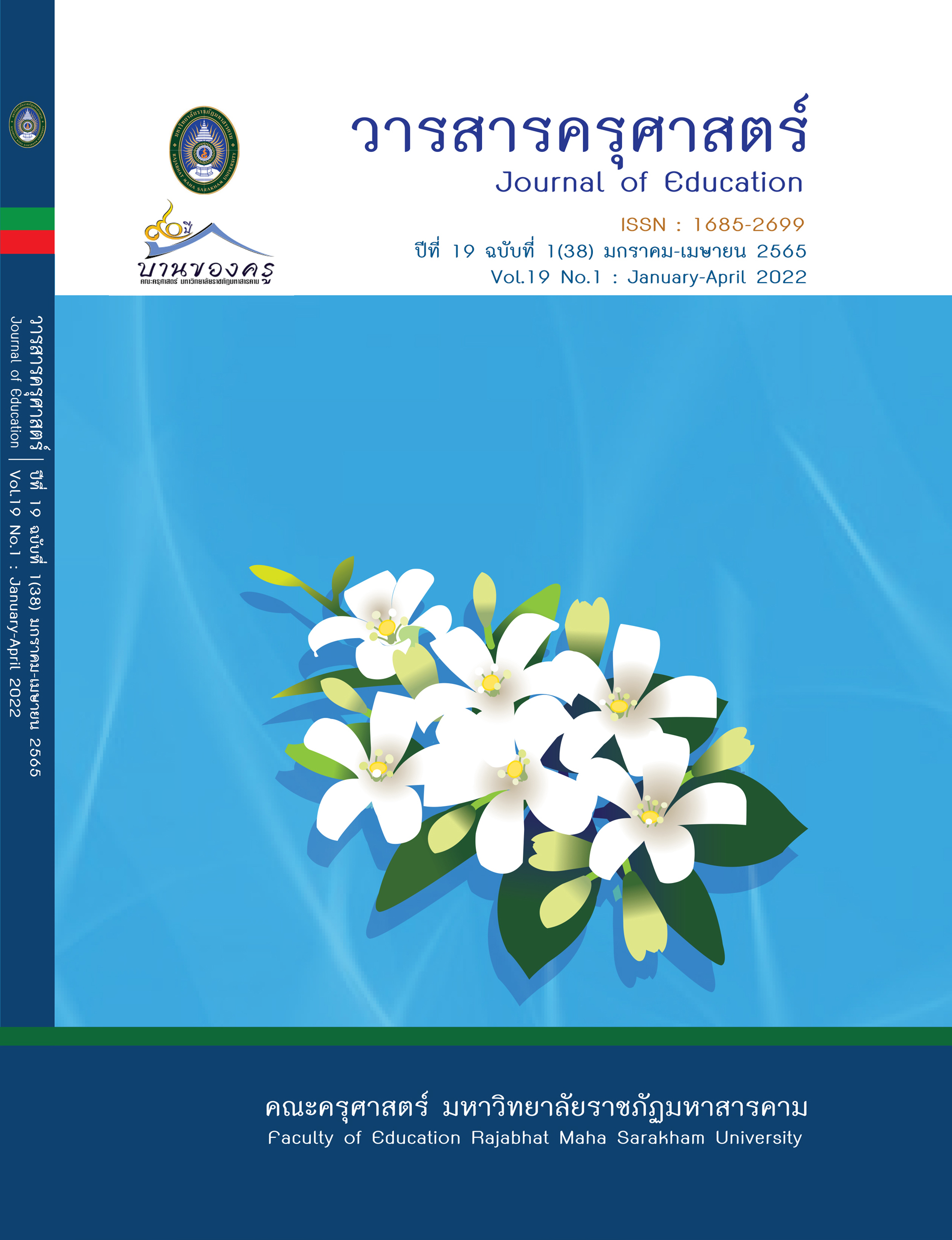Effects of 5E Inquiry Model with SSCS Technique on Chemistry Problem Solving Ability and the Learning Achievement Entitled Stoichiometry of the Tenth Grade Students
Main Article Content
Abstract
The purposes of this research were to: (1) compare the students’ pretest and post-test results on the problem-solving ability in chemistry by using the 5E inquiry model with the SSCS technique as the criteria of 60 percent, and (2) compare the students’ pretest and posttest learning achievement results by using the model and the technique. The samples of the research consisted of 25, tenth-grade students who studied at Nongmaikaen Wittaya School. The samples for the research used cluster sampling. The research instruments consisted of (1) lesson plans, (2) Chemistry problem-solving ability tests, and (3) learning achievement tests.
The research used a Dependent Samples t-test and a One-Sample t-test.
The results of the research were as follows: 1) After learning the model and the technique, the Chemistry problem-solving ability of the students’ post-test scores were higher than their pretest scores at the significance level of .05 but it was similar to the criteria as 60 percent. 2) The students’ learning achievement post-test scores were higher than their pretest scores at the significance level of .05, but it was lower than the criteria at a similar level.
Article Details

This work is licensed under a Creative Commons Attribution-NonCommercial-NoDerivatives 4.0 International License.
ข้อกำหนดเบื้องต้นที่ผู้นิพนธ์(ผู้ส่งบทความ) ควรทราบ
1. ผู้นิพนธ์ที่ประสงค์จะลงตีพิมพ์บทความกับวารสาร ตั้งแต่เดือนมกราคม 2563 เป็นต้นไป ให้ใช้รูปแบบใหม่ (Template 2563) โดยสามารถดูตัวอย่างได้ที่เมนู GUIDELINES
2. จะตีพิมพ์และเผยแพร่ได้ ต้องผ่านการประเมินจากผู้ทรงคุณวุฒิ (Peer Review)
3. การประเมินบทความโดยผู้ทรงคุณวุฒิ (Peer Review) เป็นแบบ Double Blind
4. การอ้างอิงบทความใช้หลักเกณฑ์ APA (American Psychological Association) คลิก
5. บทความถูกปฏิเสธการตีพิมพ์ ไม่ผ่านการประเมิน ผู้นิพนธ์ขอยกเลิกเองหรือชำระเงินก่อนได้รับการอนุมัติ ทางวารสารไม่มีนโยบายการคืนเงิน
References
กระทรวงศึกษาธิการ. (2551). หลักสูตรแกนกลางการศึกษาขั้นพื้นฐาน พุทธศักราช 2551. โรงพิมพ์ชุมนุม สหกรณ์การเกษตรแห่งประเทศไทย จำกัด.
จรรยา ดาสา. (2553). เทคนิคการจัดการเรียนรู้สำหรับการแก้โจทย์ปัญหาเคมีคำนวณ. นิตยสาร สสวท., 38(167), 72-78.
ชัยวัฒน์ สุทธิรัตน์. (2561). 80 นวัตกรรมการจัดการเรียนรู้ที่เน้นผู้เรียนเป็นสำคัญ (พิมพ์ครั้งที่ 8). จุฬาลงกรณ์มหาวิทยาลัย.
ชุลีพร บุตรโคตร. (2556, 7 สิงหาคม). คุณภาพการศึกษาไทยต่ำจนน่าเป็นห่วง. ศูนย์ข่าว TCIJ. https://www.tcijthai.com/news/2013/07/scoop/2919
ประสิทธิ์ ศรีกุลวงษ์. (2554). ผลของแบบฝึกการแก้โจทย์ปัญหาวิทยาศาสตร์คำนวณที่มีต่อผลสัมฤทธิ์ทางการเรียนวิทยาศาสตร์และความสามารถในการแก้โจทย์ปัญหาวิทยาศาสตร์คำนวณของนักเรียนชั้นมัธยมศึกษาปีที่ 1. [วิทยานิพนธ์ปริญญามหาบัณฑิต]. สำนักหอสมุดกลาง มหาวิทยาลัยศรีนครินทรวิโรฒ. http://ir.swu.ac.th/jspui/handle/12345 6789/881
พัชนี แสงประสิทธิ์. (2558). ผลการใช้วัฏจักรการเรียนรู้ 5E ที่เสริมกิจกรรม 4S เพื่อพัฒนาความสามารถในการแก้โจทย์ปัญหาฟิสิกส์ ของนักเรียนชั้นมัธยมศึกษาปีที่ 5 แผนการเรียนไม่เน้นวิทยาศาสตร์. [วิทยานิพนธ์ปริญญามหาบัณฑิต]. สำนักหอสมุดกลาง มหาวิทยาลัยศรีนครินทรวิโรฒ. http://thesis.swu .ac.th/swuthesis/Sci_Ed/Patchanee_S.pdf
พัชรกร ยิ่งยงยุทธ. (2560). การศึกษาความสามารถในการสร้างแบบจำลองทางวิทยาศาสตร์และผลสัมฤทธิ์ทาง
การเรียนของนักเรียนชั้นมัธยมศึกษาปีที่ 5 ที่ได้รับการจัดการเรียนรู้แบบสืบเสาะหาความรู้ 5 ขั้นตอนร่วมกับหลัก สุ จิ ปุ ลิ. [วิทยานิพนธ์ปริญญามหาบัณฑิต]. สำนักหอสมุดกลาง มหาวิทยาลัยศรีนครินทรวิโรฒ. http://thesis.swu.ac.th/swuthesis/Ed_SLM/Patcharakorn _Y.pdf
พันธ์ ทองชุม. (2544). การสอนวิทยาศาสตร์ระดับประถมศึกษา. คณะศึกษาศาสตร์มหาวิทยาลัยสงขลานครินทร์.
ศุภการณ์ ปลาสุวรรณ์. (2561). ผลการจัดการเรียนการสอนด้วยรูปแบบ SSCS ที่มีต่อความสามารถในการแก้ปัญหา ผลสัมฤทธิ์ทางการเรียน และเจตคติต่อวิชาเคมี เรื่องเคมีอินทรีย์ ของนักเรียนชั้นมัธยมศึกษาปีที่ 5. วารสารวิชาการ Veridian E-Journal, Silpakorn University, 11(2), 3373-3386.
สถาบันส่งเสริมการสอนวิทยาศาสตร์และเทคโนโลยี. (2545). รูปแบบการเรียนการสอนที่พัฒนากระบวนการคิดระดับสูง วิชาชีววิทยาระดับชั้นมัธยมศึกษาตอนปลาย. สถาบันส่งเสริมการสอนวิทยาศาสตร์และเทคโนโลยี. http://biology.ipst.ac.th/?p=688
สถาบันส่งเสริมการสอนวิทยาศาสตร์และเทคโนโลยี. (2546). การจัดการเรียนรู้วิทยาศาสตร์หลักสูตรการศึกษาขั้นพื้นฐาน. สถาบันส่งเสริมการสอนวิทยาศาสตร์และเทคโนโลยี.
สถาบันส่งเสริมการสอนวิทยาศาสตร์และเทคโนโลยี. (2560). คู่มือการใช้หลักสูตรรายวิชาเพิ่มเติมวิทยาศาสตร์ วิชาเคมี ระดับมัธยมศึกษาตอนปลาย กลุ่มสาระการเรียนรู้วิทยาศาสตร์ (ฉบับปรับปรุง 2560) ตามหลักสูตรแกนกลางการศึกษาขั้นพื้นฐาน พุทธศักราช 2551. https://www.scimath.org /ebookchemistry/item/8417-2-2560-2551
สมฤดี เลี่ยมทอง. (2557). ผลการจัดการเรียนการสอนด้วยวิธีสืบเสาะหาความรู้ที่มีต่อผลสัมฤทธิ์ทางการเรียนวิชาเคมี เรื่องปริมาณสารสัมพันธ์ ของนักเรียนชั้นมัธยมศึกษาปีที่ 4. [วิทยานิพนธ์ปริญญามหาบัณฑิต]. ศูนย์เรียนรู้และหอสมุด มหาวิทยาลัยธุรกิจบัณฑิตย์. http://libdoc.dpu.ac.th/thesis /Somruedee.Lie .pdf
สำนักงานคณะกรรมการการศึกษาขั้นพื้นฐาน กระทรวงศึกษาธิการ. (2560). ตัวชี้วัดและสาระการเรียนรู้แกนกลางกลุ่มสาระการเรียนรู้วิทยาศาสตร์ (ฉบับปรับปรุง พ.ศ. 2560) ตามหลักสูตรแกนกลางการศึกษาขั้นพื้นฐาน พุทธศักราช 2551. โรงพิมพ์ชุมนุมสหกรณ์การเกษตรแห่งประเทศไทย.
สุพรรณี ชาญประเสริฐ. (2555). การสอนเคมี : การเรียนรู้ที่นักเรียนเป็นศูนย์กลางและการวัดผลแบบ formative. นิตยสาร สสวท., 40(179), 44-46.
อดิศักดิ์ สิงห์สีโว. (2549). การพัฒนาหลักสูตรสถานศึกษาเรื่องปริมาณสัมพันธ์ที่เน้นการพัฒนาความสามารถใน
การแก้ปัญหาและการตัดสินใจ. มหาวิทยาลัยศรีนครินทรวิโรฒ.
Baroody, A. J. (1993). Problem Solving, Reasoning, and Communicating, K-8 Helping Children Think Mathematically. Macmillan Publishing Company.
Bloom, B. S. (1976). Human Characteristic and School Learning. McGraw-Hill.
Davis, K. (1977). Human Behavior at Work. McGraw-Hill.
Gokhan, D., & Gulsen, C. (2014). The effect of laboratory activities based on 5e model of constructivist approach on 9th grade students' understanding of constructivist approach on 9th grade students' understanding of solution chemistry. Procedia-Social and Behavioral Sciences, 116, 3120-3124. https://www.sciencedirect.com/science/article/pii/S1877042814007368
Ong, E. T., & Keok, B. L. (2020). The Effect of 5E Inquiry Learning Model on the Science Achievement in the Learning of "MAGNET" Among Year 3 Students. Jurnal Pendidikan IPA Indonesia, 9(1), 1-10. https://www.researchgate.net/publication/340868592_The_Effect_of_5E_Inquiry_Learning_Model_on_the_Science_Achievement_in_the_Learning_of_Magnet_among_Year_3_Students
Pizzini, E. L., & Shepardson. (1989). A Rationale for ant the Development of a Problem Solving Model of Intruction in Science Education. Science Education, 73(5), 523-534. https://onlinelibrary.wiley .com/doi/10.1002/sce.3730730502
Senol, S., & Ozge, O. (2016). The Effects of 5E Inquiry Learning Activities on Achievement and Attitude toward Chemistry. Journal of Education and Learning, 6(1), 1-9. https://scholar.google.co.th /scholar?q=The+Effects+of+5E+Inquiry+Learning+Activities+on+Achievement+and+Attitude+toward+Chemistry&hl=th&as_sdt=0&as_vis=1&oi=scholar
Sternberg, R. J. (1986). Critical Thinking: Its Nature, Measurement, and Improvement, https://files.eric.ed.gov/fulltext/ED272882.pdf


